Author: Ekko An & Ryan Yoon
Source: Tiger Research
Compiled by Shaw Jinse Finance
TL;DR
The global digital asset custody market is expected to expand by more than 50%, from US$447.9 billion in 2022 to US$683 billion in 2024, evolving from basic custody functions to core infrastructure for institutional participation.
Custody service providers can be broadly categorized into three models: traditional custodians prioritize regulatory trust and compliance; hybrid models pursue service diversification; and technology providers compete through security and API-based infrastructure. Jurisdictions such as Singapore, Hong Kong, Japan, and South Korea have each developed unique local custody frameworks.
The future of the custody business depends not only on the growth of assets under custody, but also on how service providers deliver financial services on top of the custody infrastructure. A deep understanding of regulations and the ability to adapt to local regulations will continue to be decisive factors for global expansion and the success of new entrants.
1. Why is the hosting market so important?
Since its entry into the regulated financial system, the digital asset custody industry has grown rapidly. Initially, custodial services played a limited role, primarily holding digital assets for exchanges. However, as institutional demand grew, the client base became more diverse and extensive. The rise of digital asset exchange-traded funds (ETFs) and digital asset treasury reserves (DATs) further fueled institutional participation, leading to a significant increase in the overall size of assets under custody .
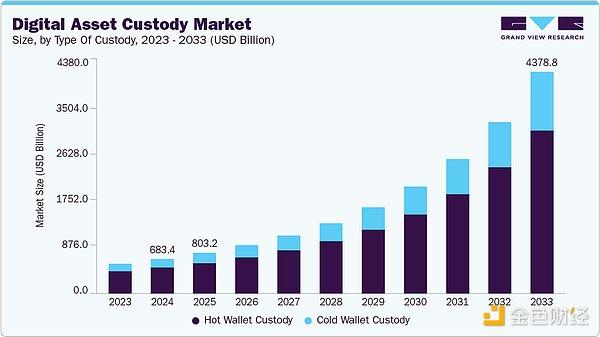
This trend is reflected in market data: the global digital asset custody market is projected to grow from approximately $447.9 billion in 2022 to $683 billion in 2024, representing an increase of over 50% in just two years . This growth is accelerating, with multiple reports projecting an average annual growth rate of 17% to 25% for the digital asset-centric custody market . Given the current wave of institutional capital inflows and the continued expansion of regulatory infrastructure, actual growth is likely to exceed these projections.
As the volume of assets requiring custody continues to grow, so too does the need for secure and reliable service providers. This report explores the evolution of the custody market and examines how different jurisdictions structure and regulate their custody frameworks.
2. The crisis-driven hosting industry
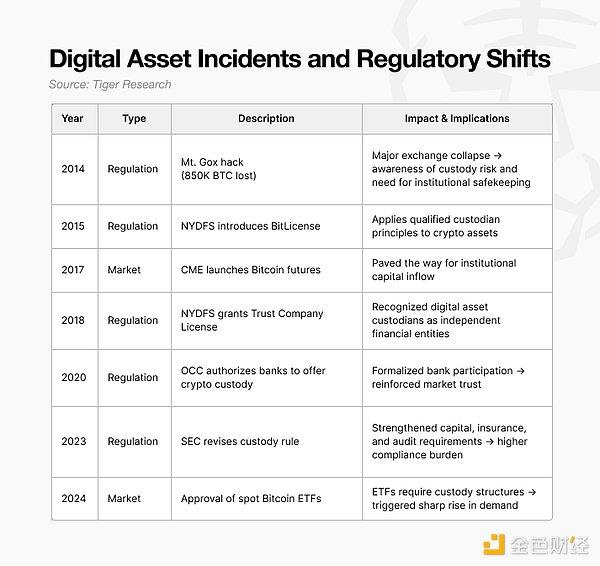
The custody industry emerged amidst a crisis. The turning point was the 2014 Mt. Gox incident in Japan , when approximately 850,000 bitcoins were stolen, causing significant losses to users. This incident served as a wake-up call for the entire industry: without institutional mechanisms to safeguard digital assets, it's impossible to operate a sustainable business in the market.
This understanding has driven regulatory progress. Following the Mt. Gox incident, the regulatory framework for digital asset custody has gradually evolved. The United States, in particular, has established custody standards similar to those in traditional finance. These regulatory developments have laid the foundation for a clearer and more robust framework, enabling the custody industry to develop under clear standards.
3. Types of hosting services
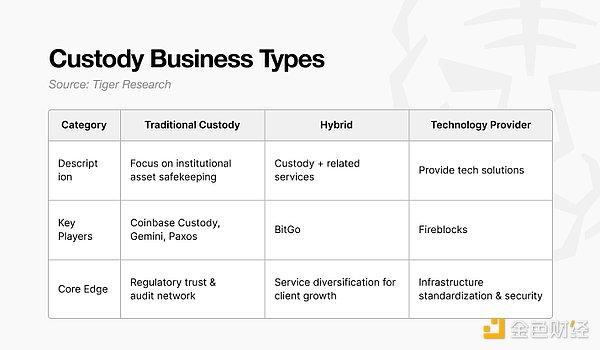
Although most custody service providers focus on core asset custody functions, their market positioning and competitiveness vary significantly due to their different strategic focuses. In general, custody services can be divided into three models:
Traditional custody model : focuses on asset custody, similar to traditional financial custodians.
Hybrid models : Going beyond custody to provide value-added services such as staking, settlement or reporting.
Technology Provider Model : Provides hosted infrastructure as a SaaS-based solution, enabling institutions to operate their own hosted systems.
Each model targets different customer groups and needs and competes based on its operational advantages and service depth.
3.1. Traditional hosting
Traditional custodial service providers primarily focus on asset safekeeping . Their core value lies in building trust through a proven track record, thereby becoming a trusted custodian for institutional investors . Coinbase Custody is a leading provider of these services.
Coinbase's strength is clearly demonstrated in the US spot ETF market. As of 2025, nine of the 11 Bitcoin spot ETFs approved by the US Securities and Exchange Commission (SEC) are hosted by Coinbase, as are eight of the nine Ethereum ETFs. This strong market share makes Coinbase Custody the most trusted institutional custodian in the industry.
The company's credibility stems from its early regulatory compliance. In 2018, Coinbase Custody received a limited purpose trust charter from the New York Department of Financial Services (NYDFS). In 2025, the company was also certified by the SEC as a qualified custodian under asset custody regulations. This designation gives it the same legal authority to hold customer assets as banks and broker-dealers.
While many competitors have only just received similar licenses, Coinbase has already accumulated years of experience operating under regulatory oversight. This experience has become a decisive factor in attracting institutional clients. In the custodial services sector, while technological maturity is certainly important, a proven operational history remains a key indicator of trust.
Ultimately, the core advantage of the traditional custody model lies in its proven track record . Even technologically advanced new entrants find it difficult to surpass existing custodians whose credibility is based on their regulatory history and operational records.
3.2. Hybrid Hosting
Hybrid custody models build on basic custodial services and expand into integrated services that combine custody, trading, and asset management . Essentially, they offer institutional clients a one-stop solution, from storage to access. BitGo is a prime example.
BitGo's service portfolio extends beyond custody to include staking, over-the-counter (OTC) trading, lending, and the tokenization of real-world assets (RWAs). Through institutional-grade wallets and APIs, BitGo integrates custody with fund management systems, while its staking services are directly linked to custodial accounts. BitGo's OTC business is licensed by Germany's Federal Financial Supervisory Authority (BaFin).
BitGo has achieved rapid global expansion through its diverse service offerings. By entering flexible regulatory environments such as Hong Kong, Singapore, and Abu Dhabi early on, BitGo established a strong local presence and quickly amassed an institutional client base.
The core advantage of the hybrid model lies in its diversified custody offering . It goes beyond storage to offer interconnected services encompassing trading, asset management, and tokenization . While traditional custodians thrive on regulatory trust, the hybrid model gains momentum through service expansion.
3.3. Technology Provider
Essentially, the technology provider model doesn't directly hold digital assets . Instead, it provides SaaS infrastructure that enables banks, exchanges, and fintech companies to manage their own custody systems . A leading player in this space is Fireblocks.
Fireblocks' technological strength makes it a preferred partner for building secure digital asset infrastructure. Major clients such as Bank of New York Mellon, Galaxy Digital, and Crypto.com demonstrate its market credibility. By 2025, its platform managed over $200 billion in assets and served over 1,800 institutions. Its extensive experience and technological reliability make Fireblocks a preferred provider of institutional custody solutions.
In 2024, Fireblocks received a limited purpose trust charter from the New York State Department of Financial Services (NYDFS), granting it the legal authority to directly hold assets. However, the company remains primarily focused on technology services. This charter serves more as a means of building trust for institutional clients than as a shift in business direction. While Fireblocks has evolved into an infrastructure company capable of directly custodial assets, it has strategically leveraged this position to solidify its leadership as a technology-first provider.
4. Local strategies under different national regulations
Financial regulation varies significantly across jurisdictions, and custody services must adapt to these local frameworks. Due to varying regulatory standards across countries, the demand for locally compliant service providers continues to grow. Even in markets less developed than the United States (where ETFs and DATs are already well established), specialized local custody solutions have emerged to accommodate each country's regulatory landscape.
Singapore
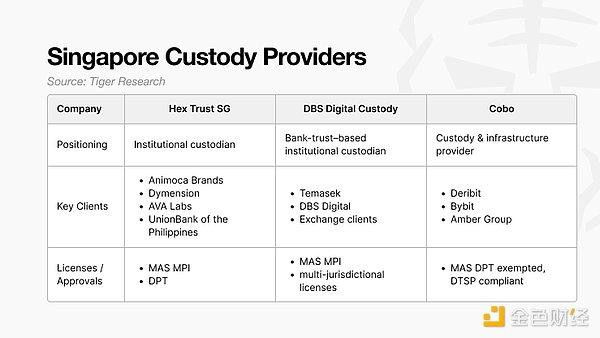
Effective June 30th, Singapore expanded the scope of the Financial Services and Markets Act (FSMA) to include custody services in the definition of digital asset services. Under this amendment, even custodians serving only overseas clients must obtain approval from the Monetary Authority of Singapore (MAS) to operate locally. MAS has stated that it will strictly enforce licensing standards for custody services, meaning that market participants will be primarily limited to banks and institutional-level entities.
4.2. Hong Kong
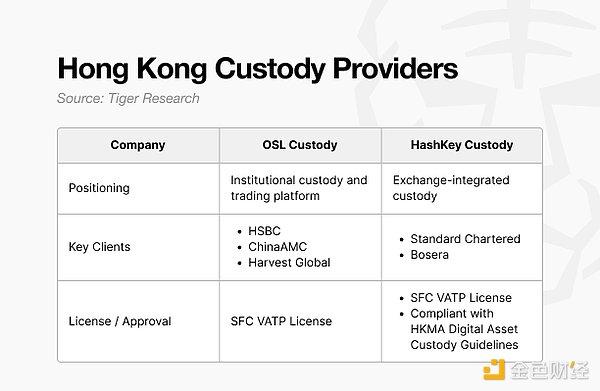
In 2023, the Hong Kong Securities and Futures Commission (SFC) launched the Virtual Asset Trading Platform (VATP) regime, which consolidates trading and custody functions under a single regulatory framework. This framework goes beyond a simple registration system and requires dual authorization for both trading platforms and custody functions.
OSL provides comprehensive custody, over-the-counter (OTC) trading, and tokenization services, and operates its own exchange. Currently, OSL provides custody services for three of the four approved spot digital asset ETFs in Hong Kong. HashKey, in partnership with Standard Chartered Bank, offers fiat deposit and withdrawal services to institutional clients, and utilizes its proprietary infrastructure to improve settlement efficiency between digital assets and fiat currencies.
Hong Kong's regulatory direction is clear: it emphasizes a "regulatory + banking partnership" model . While Singapore's custody ecosystem has developed through collaborations between local firms and global service providers, Hong Kong's approach centers on collaborations between traditional financial institutions and local custodians to attract institutional capital.
4.3. Japan
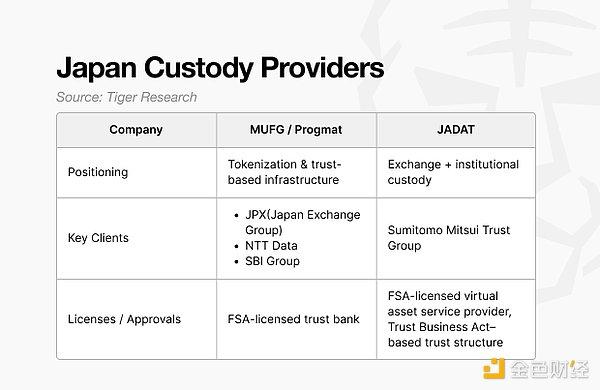
Japan's Financial Services Agency (FSA) implements a strict custody framework that prioritizes the protection of customer assets. Custodians must store at least 95% of customer assets in offline cold wallets. The remainder is held in hot wallets and must be fully collateralized with an equivalent amount of fiat currency or bonds. Furthermore, external audits are mandatory.
Due to strict regulatory requirements, Japan’s custody market is dominated by traditional financial groups rather than Web 3 native companies . Only institutions with sufficient capital and strong infrastructure can meet the FSA’s standards.
Mitsubishi UFJ Financial Group (MUFG)/Progmat specializes in tokenization and trust-based infrastructure, leveraging its FSA-licensed trust bank status. JADAT employs a hybrid model, combining exchange and institutional custody capabilities. It holds both a virtual asset exchange license and a trust business license under the Trust Business Act, enabling it to provide comprehensive trading and custody services.
The Japanese example illustrates how strict regulation has amplified the influence of traditional finance. High collateral requirements and mandatory audits have enabled banks and trust companies to become the dominant custodians in the market.
South Korea
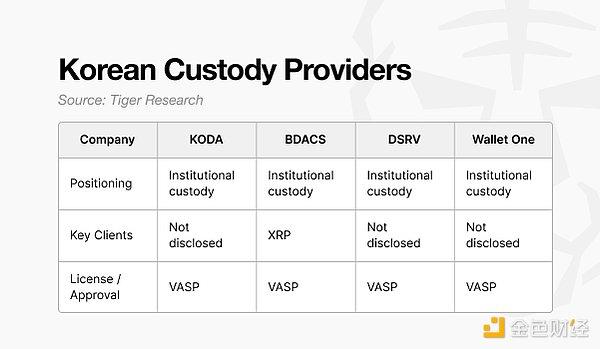
South Korea's custody industry is regulated by the Specified Financial Transaction Information Reporting and Use Act (referred to as the "Specified Financial Information Act" or the "VASP Framework"), which regulates virtual asset service providers. The Korean market exhibits two parallel trends: a partnership model led by financial institutions and a technology-driven professional model. These models range from joint ventures led by traditional financial institutions (such as KODA) to startups that differentiate themselves through security and infrastructure innovation.
Recently, exchanges have begun actively competing to attract corporate clients to support the second phase of the Financial Supervisory Commission (FSC)'s corporate digital asset trading roadmap. It is expected that demand from institutional clients will increase after the official opening of the corporate trading market.
A near-term turning point for South Korea's custody industry will be the participation of approximately 3,500 qualified professional investors. If institutional investors begin to enter the market in large numbers, the industry could move toward security token offerings (STOs) and the tokenization of real-world assets (RWAs). Therefore, regulatory consolidation not only addresses compliance requirements but can also serve as a catalyst for the formation of new markets.
5. The hosting industry is just getting started
The hosting industry is still in its early stages. Its competitive strategies can be roughly divided into two types.
The first is early market entry , such as Coinbase Custody, which established market dominance by building institutional trust and a strong customer base ahead of its competitors.
The second is service diversification , such as BitGo, which achieves differentiated competition by providing services such as staking, RWA tokenization and lending.
As the digital asset market shifts from retail dominance to institutional participation, custody service providers are working to develop bank-grade infrastructure and audit frameworks that meet institutional standards. At the same time, technology infrastructure providers that can help new entrants build compliant custody systems are also gaining attention.
However, successful market entry depends on a deep understanding of the local regulatory framework and ecosystem dynamics.
In the U.S. , regulatory approval is crucial to building institutional credibility, though new entrants will have to compete with Coinbase Custody’s strong position.
In Hong Kong and Singapore , success has relied on a collaborative model with banks under clear oversight.
In Japan , strict rules for protecting client assets make establishing partnerships with large domestic financial institutions a prerequisite for market entry.
In South Korea , there is a diversity of players, but institutional participation is still developing and has room for growth once regulatory clarity improves.
Ultimately, companies seeking to enter the custody market must prioritize precision over speed. Sustainable growth depends on accurately analyzing local regulations and designing robust partnership structures with financial institutions. Even latecomers can find meaningful opportunities as long as their business models align with regulatory requirements and they establish reliable local partnerships.







